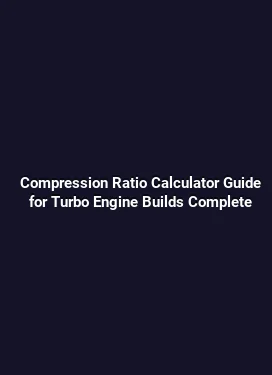Best Piston Ring Gap Settings for Turbocharged Engines: A Comprehensive Guide
Understanding the Role of Ring Gaps in Turbocharged Engines

In turbocharged applications, piston ring gaps play a pivotal role in sealing, oil control, and thermal management. The presence of boost pressure increases cylinder pressure and heat, which can influence how rings seat, how gases flow past the rings, and how quickly deposits form. Selecting the appropriate ring gap is more than a fixed number; it’s a balance between minimizing blow-by, avoiding ring land stress, and maintaining reliable lubrication under elevated temperatures. By examining materials, bore finish, and boost strategies, technicians can tailor gaps to the specific engine build and intended rpm range.
Understanding the interaction between seal geometry and dynamic load is essential for modern performance engines. The gap allows the ring to expand with heat, maintain contact with the bore, and control gas flow during both the compression and power strokes. In turbocharged builds, gap adjustments can influence knock resistance, scuff risk, and overall drivetrain efficiency. The goal is a seal that maintains integrity across a broad operating envelope without sacrificing durability.
Why Ring Gap Matters Specifically in Turbocharged Builds
Turbocharged engines confront higher cylinder pressures and accelerated gas dynamics. An overly tight gap can impede proper ring movement as the ring expands, potentially leading to micro-seizures or scuffing under high boost. Conversely, a gap that is too large may permit increased blow-by, oil consumption, and reduced cylinder pressure, undermining the turbo’s efficiency. The correct gap acts as a thermal expansion allowance, a lubrication channel, and a means to sustain ring seating under transient boost spikes.
LSI-oriented considerations include how gap interacts with bore finish quality, ring type (compression, scraper, oil control), and the presence of a turbocharger with intercooling. The modern machinery often requires harmonizing gap settings with sensor-driven management strategies that adjust boost, ignition timing, and fueling. While those strategies are outside the scope of gap sizing itself, recognizing their influence helps in crafting a robust, repeatable setup for both street and track use.
Typical Gap Recommendations by Engine Type and Bore Material
There is no one-size-fits-all number for piston ring gaps in turbo builds. Recommendations vary with bore diameter, material, and whether the engine uses a forced induction setup with high-bleed gates or variable geometry. Typical ranges for performance-oriented turbo engines often fall within a few thousandths of an inch, but the exact value depends on bore finish, ring design, and the maximum engine speed. For example, engines with a nickel- and chrome-plated bore may tolerate slightly different gaps than those with a modern ceramic or plasma-spray coating. The choice of ring material—piston rings made from chrome-iron alloys versus multi-metal composites—also shifts the optimal gap because thermal expansion and surface hardness differ between materials.
In practice, many engineers start with conservative defaults from the ring manufacturer, then validate with engine dynamometer testing and controlled road runs. Gaps can be fine-tuned around the engine’s RPM range where the turbo is most active, ensuring seals remain robust under boost while maintaining acceptable oil consumption. It is essential to log data for blow-by, oil temps, ring wear, and cylinder pressure during tuning sessions to guide incremental adjustments.
Measuring and Setting Ring Gaps: Step-by-Step Procedures
Accurate measurement is the foundation of a reliable ring gap. The following steps outline a precise approach suitable for high-performance builds. Begin with a clean bore, proper ring seating, and a torque-accurate crankcase assembly. Use calibrated feeler gauges with fine increments to capture the true gap at the location where the ring sits in the bore. Repeat measurements across multiple positions within the ring land to detect any taper or eccentricity in the bore. Subtle variations can have meaningful effects at elevated boost and temperatures.
1) Choose the correct ring orientation and ring end-gap closing method prescribed by the manufacturer. 2) Install the ring into the bore at the top, then rotate the ring to ensure it sits squarely. 3) Use the appropriate feeler gauge to measure the end gap at multiple clock positions. 4) Record the minimum and maximum gaps to assess consistency. 5) If adjustments are needed, carefully trim the ends using the recommended procedures, avoiding damage to sharp edges. 6) Re-measure to confirm the final gap and repeat for each ring type in the set.
After installation, run a controlled engine break-in with a monitored temperature profile to observe how gaps behave under real heat. Tracking the gap change with temperature provides insight into whether the ring lands are expanding as expected. This validation process helps ensure that the gaps remain within the designed tolerance during normal operation and under boost spikes.
Impact of Boost Pressure and Ring Material on Gap Performance
Boost pressure directly amplifies combustion pressure, which in turn alters the effective contact pressure between the ring and bore. Higher contact pressure can improve sealing but may accelerate wear if the gap is not well matched to thermal expansion. Ring materials with higher thermal conductivity and stability under heat, such as certain chromium-iron alloys or modern high-strength composites, will respond differently to the same gap setting. In some cases, a slightly wider gap can help manage excessive heating in a turbocharged engine that frequently operates at high boost levels.
Lubrication is another critical factor. Adequate oil film formation between ring and bore reduces friction and helps dissipate heat, but oil control rings also rely on gap behavior to manage oil bleeding into the combustion chamber. When selecting gaps, engineers consider the interplay of ring density, bore finish, and lubrication strategy to avoid either scuffing or oil dilution that could degrade turbocharged performance.
Durability and Tuning Considerations for Longevity
Durability hinges on ensuring ring gaps do not contribute to knock, excessive blow-by, or early wear. In high-boost applications, consistent ring contact during rapid transients is essential. A gap that is too tight may lead to ring binding under rapid expansion, whereas a gap that is too wide can exacerbate blow-by and oil consumption, especially at high RPMs where piston speeds increase. Tuning strategies often pair gap optimization with controlled boost ramp rates, carefully scheduled ignition timing, and precise fuel delivery to minimize peak cylinder pressures that stress the rings.
Regular monitoring of cylinder leakage, ring wear patterns, and oil cleanliness provides actionable data to refine gap settings over the engine’s life. For engines frequently subjected to track sessions or sustained high-load operation, set-and-test cycles should be integrated into maintenance plans to preserve sealing performance and reduce the risk of ring land damage.
Thermal Management and Its Influence on Gap Behavior
Turbocharged engines generate significant heat, not only in the exhaust path but within the piston crown region. Efficient cooling and heat dissipation influence how the ring lands expand and how the end-gap grows during operation. The thermal expansion coefficient of the piston, ring, and bore materials determines how much the gap will change with temperature. Engines designed with robust cooling systems and well-tuned intercooling can maintain more stable gap behavior under boost, enabling tighter gaps without sacrificing reliability. Conversely, engines with marginal cooling require more conservative gaps to accommodate higher thermal expansion and maintain sealing integrity.
Practical Testing Protocols for Real-World Validation
Transitioning from theory to practice requires structured testing. Start with a baseline configuration that uses manufacturer-recommended gaps for natural aspiration or the initial turbo-specific values if provided by the piston ring supplier. Conduct controlled dynamometer pulls at various boost levels, capturing cylinder pressure curves, ring seal indicators, and oil temperature. Use high-resolution data logging to correlate gap performance with boost, RPM, and load. Incrementally adjust gaps by small increments, re-testing to observe trends and identify the point at which sealing efficiency and wear balance optimally under your operating envelope.
In addition to lab testing, field validation under race or track conditions can reveal gap behavior under real-world heat soak and boost transients. Documenting fuel quality, oil type, and ambient conditions helps in comparing results across sessions and ensures that changes in the gap setting yield consistent improvements rather than session-specific anomalies.
Common Mistakes to Avoid and Troubleshooting Tips
Several recurring mistakes can undermine ring gap effectiveness in turbocharged builds. Overly aggressive gaps without adequate cooling can lead to accelerated wear and ring land damage. Pretensioning or improper end-gap finishing can produce unpredictable results, causing early ignitions or blow-by. It’s essential to follow the manufacturer’s guidelines for end-gap shaping and to verify that all rings are correctly oriented. Misalignment of rings during assembly can create false readings and inconsistent sealing that only become apparent after heat cycles.
When troubleshooting, prioritize data-driven decisions. If oil consumption rises or blow-by increases after a tuning change, recheck ring gaps and verify bore cleanliness and surface finish. If knock or pre-ignition occurs under boost, re-evaluate gap settings in conjunction with ignition timing and fuel mixture. A holistic approach that considers gap behavior alongside boost strategy and lubrication yields the most reliable long-term results.
Practical Examples: Gap Settings Across Different Turbo Scenarios
Example A involves a 2.0L four-cylinder built for street/highway use with moderate boost. Starting with a mid-range gap and validating with a balanced oil temperature profile yields a robust seal with minimal oil pull. Example B tackles a 3.0L V6 track-focused build with high boost and aggressive timing. A slightly wider gap helps accommodate thermal expansion and maintains ring stability at elevated RPMs, while monitoring for any uptick in blow-by during hard acceleration. In both cases, the key is progressive testing, clear measurement criteria, and a disciplined data logging protocol that correlates gap performance with engine behavior over a range of loads.
Linking Ring Gap Settings to Overall Engine Management Strategy
While ring gap tuning is a mechanical task, its success is amplified when integrated with a holistic engine management approach. Collecting and analyzing data on cylinder pressure, exhaust gas temperature, and AF ratio under different boost conditions provides the feedback necessary to refine gap choices. The orchestration of boost control, fuel strategy, and ignition timing with precise gap settings can unlock predictable performance gains while maintaining reliability. This synergy between hardware configuration and software controls is a hallmark of modern performance tuning, enabling engines to perform aggressively without compromising long-term durability.
Summary of Key Takeaways for Turbocharged Ring Gap Optimization
Optimal piston ring gaps in turbocharged engines depend on bore material, ring design, cooling efficiency, and the boost strategy. Accurate measurement and careful testing are critical to identifying the gap that achieves a robust seal, minimizes blow-by, and preserves lubrication quality under heat. Material properties and thermal expansion must guide gap decisions, while practical validation through dyno testing and real-world drives confirms performance gains. By combining precise mechanical setup with informed data-driven tuning, turbocharged engines can attain stronger seals, better efficiency, and enduring reliability across a broad operating envelope.
Measuring and Setting Ring Gaps

Accurate end-gap measurement requires clean components, proper seating within the bore, and the use of calibrated gauges. The procedure should be performed with the engine cold and then repeated after a controlled heat soak to understand how gaps behave under operating temperatures. Always follow manufacturer guidance for end-gap finishing, avoid over-reduction of the gap, and verify consistency across all rings and positions within the bore. This disciplined approach ensures reproducible results and reduces the risk of failure during high-load operation.
Practical Testing Protocols
Build a testing matrix that includes baseline gaps, incremental adjustments, and multiple boost scenarios. Use a data logger to capture cylinder pressure, crank angle, and oil temperature. Compare results across each test to identify the gap value that provides the best balance of sealing and durability. Document all conditions, including fuel grade and ambient temperature, to facilitate accurate comparisons across sessions.






